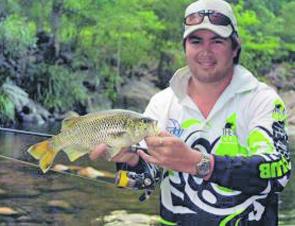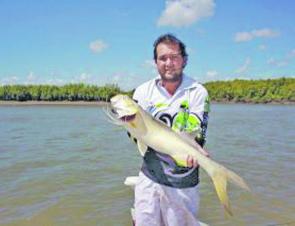Welcome back! We’ve had some great rain which not only gave relief to my garden, but also encouraged spawning fish to get busy so we can look forward to another flawless year of fishing in 2012. Firstly I hope everyone had a merry Christmas and hope the New Year kicked off with new fishing gear and happy times.
With the barra closure now in full swing it’s good to see anglers turning their attention to mangrove jacks. Last year was a phenomenal year for jacks both in the creeks and offshore, which is a healthy sign that the habitat they call home is thriving. 2011 saw reasonably rough weather throughout the year which may have allowed the breeding jacks to get the job done and replenish creek stocks for this year.
Plenty of land based anglers around Townsville have found healthy fish while fishing around notorious locations such as Aplins Weir, Rooney’s Bridge, the Lakes and the bridges in Ross Creek. Bait anglers prefer small poddy mullet as live offerings and the ever reliable cubed pilchard is hard to beat as well.
Lure enthusiasts have a simple rule for jack fishing and that’s fishing lures to the depth at hand. Shallow areas with structure would see small slow sinking soft plastics worked as close to the structure as possible, with surface lures just as effective at times. Deeper areas like the bridges mentioned will see the use of traditional soft plastics or vibe type lures cast and let sink to the bottom. From here hopping lures back past the structures can produce just about anything, but hopefully a jack. Always remember ‘out of sight, out of mind’, which simply means get it as close to the fish as you can.
Those using this theory in the deeper stretches of water both inshore and offshore have had remarkable success. Using vibes and soft plastics close to the bottom has unlocked some of the more desirable fish such as the threadfin salmon. These fish are often thought of as a fish predominantly caught in plague proportions up north, however anglers find it a real challenge to capture just one in these waters. That being said, evidence shows that they are here and in healthy numbers. Fish up to a metre in length are common with a few fish dwarfing the brag mat at around 120cm.
Another species that will become talk of the town during the barra closure is golden snapper. This is the second in line after the barramundi to many anglers and the more traditional methods of bait fishing seems to be the more popular. Local haunts such as West Point, Orchid Rocks and Cape Cleveland still hold quality fish with live baits at night the most productive method of choice. A squid light is a must on any fingermark session and a fine mesh scoop net will help secure the squid once they come to the light. Make sure you fill the well with live mullet before you leave the ramp, as sometimes the squid just don’t show up.
Recently the turn to soft plastics and jigs to catch these monsters have proven so successful that day or night doesn’t make any difference. Some of the biggest fingermark I’ve seen to date have come while the sun is high above head. Some popular lures have been Koolabung Blades, Gulp soft plastics both 6” jerk shads and 6” new Squid Vicious. Lures must be worked close to the bottom and fish using the lightest jighead you can get away with. You will be surprised how many more bites you will get if you go light Good luck!
Do it cos ya love it!
Reads: 2996
Dale Mitchell displays one of many jungle perch caught during a recent trip in the fresh.

Jake Mitchell with a quality threadfin salmon caught while working the deeper water.

Karim De Ridder with his personal best golden snapper.




